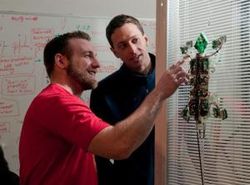1.9.2010 | 11:54
Rannsóknir á hönnun í náttúrunni
 Ţađ er mikiđ um ađ vera í rannsóknum á náttúrunni og tilraunum vísindamanna ađ herma eftir ţeirri hönnun sem ţar er ađ finna. Fyrir mig ţá eru ţetta dćmi um rannsóknir í anda Vitrćnnar hönnunar, ţ.e.a.s. rannsaka náttúruna og komast ađ ţví hvernig viđ sem vitrćnir hönnuđir getum hermt eftir ţessum hlutum og lćrt sitthvađ um hönnun.
Ţađ er mikiđ um ađ vera í rannsóknum á náttúrunni og tilraunum vísindamanna ađ herma eftir ţeirri hönnun sem ţar er ađ finna. Fyrir mig ţá eru ţetta dćmi um rannsóknir í anda Vitrćnnar hönnunar, ţ.e.a.s. rannsaka náttúruna og komast ađ ţví hvernig viđ sem vitrćnir hönnuđir getum hermt eftir ţessum hlutum og lćrt sitthvađ um hönnun.
- Embryo trick: Scientists inspired by the cilia that embryos use to direct cells to their places copied the trick with “biomimetic cilia” they hope to use with lab-on-a-chip applications (see abstract at PNAS).
- Stickybot: Inspired by gecko feet, scientists at Stanford designed a look-alike robot, reported Science Daily, that uses the same principle of dry adhesion by multiplication of surface contacts. “The material is strong and reusable, and leaves behind no residue or damage,” just like a gecko foot, the article said. They even imitated the gecko’s rotating ankles so that it can change direction.
- Perfect little engine: Ever heard of a salp? This small jelly-like creature lives in the sea and is important for carbon cycle. Science Daily told about its “near-perfect little engine” that propels it and filters its food with a microscopic mesh. Because “the scientists are captivated by the unique, almost magical performance of this natural undersea engine,” they think inventors could learn something. Science Daily asked, “What if trains, planes, and automobiles all were powered simply by the air through which they move? Moreover, what if their exhaust and byproducts helped the environment? Well, such an energy-efficient, self-propelling mechanism already exists in nature.”
- Beetle bifocals: Scientists at the University of Cincinnati were stunned to find a diving beetle with bifocal compound eyes. Live Science reported that the eyes have two retinas, one for distance and one for close-up inspection. Analysis of how this unique beetle sees could help bifocal manufacture. “Bifocal glasses and contacts create two images that interfere with each other, creating an area of blur,” the article said. “The beetle larvae solve this interference problem by having focal planes are slightly shifted so they aren’t completely on top of each other. In fact, the researchers found the shift of the focal planes improved contrast of the resulting image three-fold.”
- Oyster glue: The Navy is employing “interdisciplinary, cutting-edge research” to copy oysters. The amazing underwater adhesives that oysters use are attractive to the Navy not only because of their importance to the marine ecology, but also because of the insights they provide. Naval researchers have been “studying marine animals’ various adhesives, uncovering fundamental properties that could yield new innovations from replacements for medical sutures to surface coatings that keep waterborne craft from picking up marine hitchhikers,” the article said. They found that oysters have a unique adhesive for sticking to one another as they build oyster reefs.
- Put on your bacteria: New Scientist posted an unusual article and video about researchers using bacteria to grow fibers for clothing. Such biodegradable clothing will be “green” not necessarily in color, but in the sense of being biodegradable and environmentally-friendly.
- Code in the nose: Inventors have been working on artificial noses for some time, with only mixed results at distinguishing the thousands of odors that natural noses are so good at detecting. PhysOrg reported that Stanford inventors are finding that a touch of DNA helps. The combinatorial flexibility of DNA is providing the coding repertoire for sensors to respond to many more molecules than before. Live Science added that frog egg cells are providing a key ingredient in robotic noses as receptors.
- Cornea breakthrough: Synthetic corneas are too hard to make, and cornea transplants are expensive and difficult, so why not regrow the real thing? The BBC News reported that biosynthetic implants, using “a synthetic version of human collagen designed to mimic the cornea as closely as possible,” are providing real hope for restoring impaired vision. Already in tests patients reported “dramatically improved” vision with the new technique.
- Pop goes the circuit: Manufacturing circuits inspired by bacteria? Why not? Synthetic circuits is a relatively new method within the “emerging field of synthetic biology” of organizing genetically-modified bacteria to “produce a myriad of useful proteins, enzymes or chemicals in a coordinated way.” Science Daily reported that scientists at Duke University were surprised to find bacterial cells popping, or committing suicide, when reaching a certain stage of plasmid density. They modeled the behavior with a sample circuit they called ePop and found that it can “increase the efficiency and power of future synthetic biology circuits.”
- Flying with altitude: Somehow, fruit flies know the right altitude for their flying and hovering needs. Live Science reported that findings about how they calculate optic flow might help designers of “insect-inspired robots.” Mike Dickinson’s team at Caltech found that flies use horizontal edges and “integrate edge information with other visual information to pick flight plans.” This work not only helps “unveil the mysteries of insect flight and cognition, but it may have practical implications for humans, as well.”
Ţessi samantekt af fréttum var tekin héđan: http://www.creationsafaris.com/crev201008.htm
Eins og vanalega ţá er ekkert gagn af ţróunartrúnni í ţessum vísindum. Örfáir eru til í ađ eyđa tíma í ađ gíska á ţađ hvernig tilviljanir og náttúruval fór ađ ţví ađ búa til ţessi hönnunar undur. Ţađ er vonandi ekki langt í ađ ţessi ţróunar trú deyi út og alvöru vísindi fái ađ blómstra án ţessara truflana.
Meginflokkur: Vísindi og frćđi | Aukaflokkur: Trúmál | Breytt s.d. kl. 12:56 | Facebook
Um bloggiđ
Mofa blogg
Fćrsluflokkar
- Bloggar
- Bækur
- Dægurmál
- Ferðalög
- Fjármál
- Fjölmiðlar
- Heilbrigðismál
- Heimspeki
- Íþróttir
- Kjaramál
- Kvikmyndir
- Lífstíll
- Ljóð
- Löggæsla
- Mannréttindi
- Matur og drykkur
- Menning og listir
- Menntun og skóli
- Samgöngur
- Sjónvarp
- Spaugilegt
- Spil og leikir
- Stjórnmál og samfélag
- Sveitarstjórnarkosningar
- Tónlist
- Trúmál
- Trúmál og siðferði
- Tölvur og tækni
- Umhverfismál
- Utanríkismál/alþjóðamál
- Vefurinn
- Viðskipti og fjármál
- Vinir og fjölskylda
- Vísindi og fræði
Tenglar
Kristnar síđur
Ýmislegt
Sköpun/ţróun
Síđur sem fjalla um sköpun/ţróun
- Detecting Design
- UnCommon descent Blogg síđa William Dembski um vitrćna hönnun
- Creation-Evolution Headlines Síđa sem fjallar um fréttir tengdar sköpun ţróun
- EvolutionNews Síđa sem fjallar um fréttir sem tengjast Vitsmunahönnun
Bloggvinir
- Bergur Thorberg
- Birgirsm
- Brosveitan - Pétur Reynisson
- Bryndís Böðvarsdóttir
- Daníel Þór Þorgrímsson
- Davíð S. Sigurðsson
- Davíð Örn Sveinbjörnsson
- Daði Einarsson
- Dóra litla
- Eva
- Eygló Hjaltalín
- Friðrik Páll Friðriksson
- Georg P Sveinbjörnsson
- Gladius
- Gunnar Ingi Gunnarsson
- Gunnlaugur Halldór Halldórsson
- Guðni Már Henningsson
- Guðrún Sæmundsdóttir
- Guðsteinn Haukur Barkarson
- Gísli Kristjánsson
- Halldóra Hjaltadóttir
- Halldóra Lára Ásgeirsdóttir
- Hjalti Rúnar Ómarsson
- Hörður Finnbogason
- Hörður Halldórsson
- Inga Helgadóttir
- Ingibjörg
- Ingvar Leví Gunnarsson
- Ingvar Valgeirsson
- Janus Hafsteinn Engilbertsson
- Jens Sigurjónsson
- Jóhann Hauksson
- Jóhann Helgason
- Jóhannes Ólafsson Eyfeld
- Jón Hjörleifur Stefánsson
- Jón Ríkharðsson
- Jón Valur Jensson
- Jónatan Gíslason
- Júdas
- Kristin stjórnmálasamtök
- Kristinn Theódórsson
- Kristinn Theódórsson
- Kristinn Ásgrímsson
- Linda
- Mama G
- Morgunstjarnan
- Nonni
- Omnivore
- Predikarinn - Cacoethes scribendi
- Pétur Eyþórsson
- Ragnar Birkir Bjarkarson
- Ragnar Kristján Gestsson
- Ragnar Steinn Ólafsson
- Ragnheiður Katla Laufdal
- Róbert Badí Baldursson
- Rósa Aðalsteinsdóttir
- Rödd í óbyggð, kristilegt félag
- Röddin
- Rúnar Kristjánsson
- Sigurður Þórðarson
- Sigvarður Hans Ísleifsson
- Steinar Immanúel Sörensson
- Styrmir Reynisson
- Svanur Gísli Þorkelsson
- Sverrir Halldórsson
- TARA
- TARA ÓLA/GUÐMUNDSD.
- Theódór Norðkvist
- Tryggvi Hjaltason
- Tímanna Tákn
- Unknown
- Vefritid
- Viðar Freyr Guðmundsson
- gudni.is
- Ólafur Jóhannsson
- Þarfagreinir
- Þórdís Ragnheiður Malmquist
- Alexander Steinarsson Söebech
- Árni Karl Ellertsson
- BookIceland
- Elísa Elíasdóttir
- Fanney Amelía Guðjonsson
- Friðrik Már
- Gestur Halldórsson
- Guðjón E. Hreinberg
- Gunnar Ingvi Hrólfsson
- Gunnar Jóhannesson
- Hulda Þórey Garðarsdóttir
- Jens Guð
- Karl Jóhann Guðnason
- Kristinn Ingi Jónsson
- Lífsréttur
- Mathieu Grettir Skúlason
- Tómas Ibsen Halldórsson
- Valur Arnarson
- Viktor
- Vilhjálmur Örn Vilhjálmsson
Heimsóknir
Flettingar
- Í dag (4.5.): 1
- Sl. sólarhring: 7
- Sl. viku: 39
- Frá upphafi: 802824
Annađ
- Innlit í dag: 1
- Innlit sl. viku: 38
- Gestir í dag: 1
- IP-tölur í dag: 1
Uppfćrt á 3 mín. fresti.
Skýringar






Athugasemdir
Rannsakiđ ţetta
Jón Ragnarsson, 9.9.2010 kl. 13:33
Jón Ragnarsson, ţegar ţróunarsinnar byrja á dćmum um "lélega hönnun" ţá eru ţeir ađ lýsa yfir sínu eigin skilningsleysi. Léleg hönnun ţarf líka hönnuđ. Síđan ţar sem sköpunarsinnar útiloka ekki náttúruval og tilviljanir ţá geta ţessi öfl skapađ hitt og ţetta, ţarf einfaldlega vísindalegar athuganir til ađ meta sérhvert tilfelli.
Taktu eftir dćminu sem kom á undan sem er augađ. Ţarna vísa ţeir í Dawkins um ađ augađ sé illa hannađ. Alvöru vísindarannsóknir hafa sýnt fram á ađ ţetta er alls ekki rétt, sjá: http://www.arn.org/docs/odesign/od192/invertedretina192.htm
Ég er nokkuđ viss um ađ eitthavđ svipađ muni reynast međ gírafann enda er nóg af snilldarhönnun ađ finna í ţessu magnađa dýri.
Mofi, 9.9.2010 kl. 14:18
Bćta viđ athugasemd [Innskráning]
Ekki er lengur hćgt ađ skrifa athugasemdir viđ fćrsluna, ţar sem tímamörk á athugasemdir eru liđin.